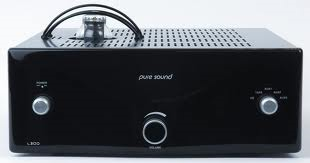L300 Line Level Pre-amplifier - Puresound
L300 has 5 inputs and twin outputs (2 pairs single ended and 2 pairs balanced via XLR). The circuit uses output transformers and a sophisticated full valve rectified, choke smoothed, regulated power supply including a 300B triode as the series element.
A Line Stage pre-amplifier needs to offer the facility to select between different sources, to provide some means of attenuating the chosen source and then deliver it in an uncorrupted form to the power amplifier.
Controlling the Volume
In recent times, with the prevalence of digital source components, many audio enthusiasts have adopted the use of passive volume controls incorporating resistive potential dividers and even transformer based attenuators. These are volume controls where attenuation is achieved through the use of tapped transformer windings. On the face of it either of these might appear to offer the purest approach. However, it’s not so simple. Resistive attenuators are generally of quite a high impedance so as not to load the source driving them but in turn confer little drive capability themselves. In some circumstances they can sound quite transparent but it’s a commonly experienced subjective impression, that such attenuators leave the music with a lack of purpose and grip. Long connecting cables may also blunt the high frequency response, a situation which may be worsened by using a following amplifier with low input impedance. Transformer volume controls seem to address the issue of drive capability to some extent, but they have their own problems. A wide bandwidth transformer can be made such that, when using both windings in full, i.e. with no attenuation, it transfers a pretty good facsimile of the source signal. However, as attenuation is applied and the transformer has to transform more and more, difficulties start to arise. By the time significant attenuation is applied, the performance of the transformer no longer looks quite as impressive with differing patterns of resonance being visible at each step. The reproduction of timbre suffers and the sound quality realized alters slightly with each change in level. Auto-formers which attenuate by tapping off a single sided winding have actually proved to be the most transparent passive controls we have tested and yet even they seem to lack a certain something.
The other issue with volume controls based on a multi position switch is a sense that the right level for listening to a piece of music can never quite be reached. If the steps of the attenuator are made close enough to suit a source with a given output or a following amplifier with a particular sensitivity, it will be wrong with another source or another amplifier. A conventional potentiometer gives a much finer range of adjustment. In the L300, source selection is via a high quality switch located near to the input sockets. The chosen source is routed to a high quality film potentiometer and from there on to the audio circuit. This consists of 2 directly coupled triode stages, the second loaded by an output transformer which steps down the amplified signal allowing it to be coupled to the power amplifier at a manageable level and via a low impedance output. The output stage of the L300 is impervious to long interconnecting cables or lower impedance power amplifier input stages. The use of output transformers also allows the option of a true balanced output configuration if desired. A low gain, low output impedance stage is in itself nothing new. Many transistor pre-amplifiers are similarly specified. However, they usually achieve it by means of excessive negative feedback which is highly detrimental to the subjective reproduction of music.
Power Supplied properly
The L300 also incorporates an extremely sophisticated regulated power supply to maintain constant operating conditions for the audio circuitry. It includes a valve rectifier, a choke filtered stage and then a series regulator featuring the 300B power triode as the passing tube. A very elaborate error amplifier referenced to a gas voltage reference valve allows the circuit to precisely maintain the high tension supply regardless of fluctuations in the mains supply and the varying current drawn by the audio circuit. Filament supplies are also fully regulated to further reduce the potential for noise. The L300 preserves the verve and energy in recordings that almost all pre- amplifiers and passive volume controls otherwise lose. It does this without sacrificing transparency or introducing euphonic colouration to the sound.


